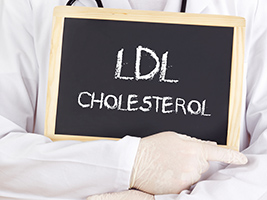 Since the 1970s, most medical institutions have stood by the view that LDL cholesterol is bad cholesterol because it hangs around in our blood streams and consequently forms plaques in our arteries that damage and block them.
Since the 1970s, most medical institutions have stood by the view that LDL cholesterol is bad cholesterol because it hangs around in our blood streams and consequently forms plaques in our arteries that damage and block them.
As a result, when you go for a cholesterol test, your doctor measures your LDL cholesterol to calculate whether you are at risk of heart disease.
If your LDL cholesterol is high, you will be pushed to take dangerous statin drugs.
A new study now suggests that this is wrong, and that lowering LDL cholesterol may be completely useless to avoid heart diseases.
To understand how this works, you should understand how cholesterol is carried in your blood stream.
Cholesterol travels through your blood stream in protein parcels called lipoproteins. The lipo (fat and cholesterol) is inside, the protein cover is around it. LDL stands for low-density lipoprotein.
In the new study, published in JAMA Cardiology, researchers treated groups of people with different substances to lower their LDL.
When their LDL alone was lowered, they showed only a small reduction in heart disease risk.
However, when their LDL was lowered in combination with something called apolipoprotein-B (normally called apoB), their heart disease risk plummeted far further.
This suggests it is apoB that needs to be lowered, not LDL cholesterol.
So, what is apoB and why is it so important?
ApoB is a protein without which these lipoprotein parcels that carry cholesterol cannot be formed. Wherever you find a well-formed LDL parcel, you will find ApoB around it.
When a laboratory measures your LDL, it measures not only the number of LDL parcels that travel through your blood stream, but also information on the size of the LDL parcels to estimate exactly how much cholesterol they are carrying.
This means that, when your LDL cholesterol drops, it may be either because the number of LDL parcels drops, or because the size of the parcels drops while their number remains the same.
When a laboratory measures your apoB, on the other hand, it measures only the number of LDL parcels, with the amount of cholesterol they carry being irrelevant.
Therefore, this new study shows that to cut your heart disease risk you need to cut the number of LDL parcels in your blood stream, not the amount of cholesterol carried by these LDL parcels.
The scientists did not speculate why this was the case, but the fact that each of our body’s cells has only one receptor to receive apoB might explain it.
Your body’s cells want to absorb the LDL that is currently travelling through your blood stream so that they can use it.
But if you have too many LDL parcels, these parcels have to wait in a traffic jam outside your cell’s limited apoB receptors before they can be absorbed.
This means that LDL parcels have to circulate through your blood stream for long periods before they can be used, increasing the chance that they will become oxidized (go rancid).
And it’s oxidized cholesterol that forms plaque in your arteries, causing stroke and heart attack.

 Overcoming IBD
Overcoming IBD Multiple Sclerosis
Multiple Sclerosis Banishing Bronchitis
Banishing Bronchitis Gum Disease Gone
Gum Disease Gone Overcoming Onychomycosis
Overcoming Onychomycosis Neuropathy No More
Neuropathy No More The Prostate Protocol
The Prostate Protocol Brain Booster
Brain Booster
 Ironbound
Ironbound
 Solution for Shingles
Solution for Shingles
 The Bone Density Solution
The Bone Density Solution
 The Ultimate Healing Protocol
The Ultimate Healing Protocol
 The Parkinson's Protocol
The Parkinson's Protocol
 The Chronic Kidney Disease Solution
The Chronic Kidney Disease Solution
 Overthrowing Anxiety
Overthrowing Anxiety The Fatty Liver Solution
The Fatty Liver Solution The Hypothyroidism Solution
The Hypothyroidism Solution
 The End of Gout
The End of Gout The Blood Pressure Program
The Blood Pressure Program
 The Oxigized Cholesterol Strategy
The Oxigized Cholesterol Strategy
 Stop Snoring And Sleep Apnea Program
Stop Snoring And Sleep Apnea Program
 The Arthritis Strategy
The Arthritis Strategy The Vertigo & Dizziness Program
The Vertigo & Dizziness Program The 3-Step Diabetes Strategy
The 3-Step Diabetes Strategy Hemorrhoids Healing Protocol
Hemorrhoids Healing Protocol The Erectile Dysfunction Master
The Erectile Dysfunction Master Weight Loss Breeze
Weight Loss Breeze The IBS Program
The IBS Program The Insomnia Program
The Insomnia Program The Migraine and Headache Program
The Migraine and Headache Program The Neck Pain Solution
The Neck Pain Solution The Menopause Solution
The Menopause Solution The Ejaculation Master
The Ejaculation Master The TMJ Solution
The TMJ Solution The Acid Reflux Solution
The Acid Reflux Solution The Fibromyalgia Solution
The Fibromyalgia Solution The Psoriasis Strategy
The Psoriasis Strategy